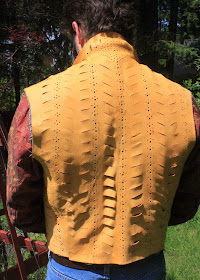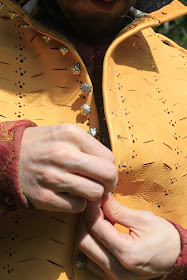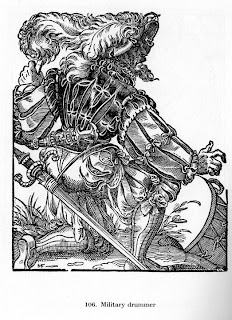
Today, I finally get off my duff and begin my leather jerkin project...
Patterning, Plotting, and Planning:Orienting pattern pieces on a piece of cloth is fairly straightforward. Cloth is woven with a definite grid of warp and weft fibers, so you know what you're going to get. Stretch on a piece of cloth runs on the diagonal (bias) because the fibers slide more easily diagonally than they do laterally.
Because leather was once the skin of an animal, it has its own concerns where placement of pattern pieces are concerned. Leather has a lot of give to it and while there are definitely directions in which the leather stretches better than in other directions, those are not necessarily uniform across the entire hide. As discussed
in the posts on mask making, the areas nearest the belly of the animal are the stretchiest.
 |
| Alcega's doublet pattern layout on a rather narrow width of cloth. |
There are a lot of other factors that play into these considerations, including the origin of the leather (cow or calf, sheep or lamb, deer or doe... etcetera.) Breed, gender, and age are huge considerations in choosing leather. Female and/or younger animals have suppler hides because their skin is higher in collagen, same as my skin is not as supple as a lad half my age. Even on leathers from the same animal, how the leather was tanned will be another consideration.
This is all compounded by the fact that unlike the cloth that comes from your local weaver, leather thickness is not uniform across the whole of the hide. So pattern pieces should be oriented so that the thinner places are along the outer edges where you were going to have to skive away leather anyway.
Pattern Placement and Cutting:
Holes you make in the leather won't 'heal' like they do in cloth. So we can't really use pins. I know some folks use them in the seam allowance, but I don't like to do so. If you feel that you cannot get by without some pins, then to the seam allowances with you!
I lay the pattern pieces on the back side of the leather and either tape them or weight them down and trace around them.
Note the way I oriented the pattern pieces in the photo above, taking the most advantage of areas of leather free of things like bullet holes and other imperfections. Unless you have in your project budget to buy multiple five-star hides and use the best of each, some imperfections are par for the course. They add character as far as I'm concerned.
Also, note how the stretchier areas at the edges are kept to the areas that will need to be stretchier and/or thinner on the final garment.
Stabilizing the Leather:
There are ways to get leather to be more stable as a final garment and I'm going to use a flat lining technique with a slightly... okay, very modern twist.
Once upon a time, I bought a leather sport coat at a thrift store and took it apart to use the leather for something else. I was surprised to discover that across the whole of the garment, the leather had been glued to a piece of lightweight interfacing.
The interfacing peeled right off, as pellon is wont to do when thumbnail is applied, but it was a bit of an "Aha!" moment for me.
A jerkin needs to be a fairly structural garment, even if made from a lighter leather. Because I'm using a very stretchy skin, I plan to adhere my leather to a denim-weight canvas using a spray adhesive. This will bond the two together so that I can treat it as one layer. This adhesion will be backed up with stitches later, but the adhesive allows me to work with it fairly roughly (note that I've used a chisel to slash one of the test bits below.)
You can use almost anything for this from lightweight pellon to a cheaper hide if you want. It all depends upon how much structure you want or need to lend your final garment.
.jpg) |
| The final pieces. Cut out and stabilized. |
Is this a period technique?
Well, 3M was founded in 1902 and probably didn't start making aerosol adhesives until the 1950's at a guess.
Flatlining certainly is. Using layers of fabric to reinforce and stiffen areas of cloth and leather garments, certainly. Gluing it on? I don't really know.
If you wanted a more period-appropriate method, do the same thing with linen or hemp canvas, adhered with hide glue. It would accomplish much the same thing, but hide glue is messy and much stiffer than the 3M spray product I used here. Which is why I opt for the modern convenience.
The adhesion provided by the glue will allow the two pieces to move as one, each lending the other its greatest strength. The denim lends the leather body and the leather (and the glue) keep the denim from fraying out too much where I've slashed it.
I'll talk more about pinking and slashing in another post.




.jpg)
.jpg)

.jpg)
.jpg)
.jpg)

.jpg)
.jpg)
.jpg)
.jpg)
.jpg)
.jpg)
.jpg)
.jpg)
.jpg)
.jpg)

.jpg)

.jpg)

+(2).jpg)



.jpg)
.jpg)
.jpg)
.jpg)
.jpg)
.jpg)
.jpg)
.jpg)
.jpg)
.jpg)
.jpg)




